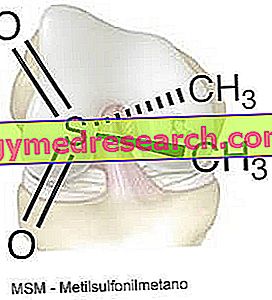Generality
Anencephaly is a very serious congenital malformation due to failure to develop the brain and skull bones . This condition is not, unfortunately, compatible with life: the children who are affected are destined to die prematurely or survive only for a few hours.

Preventive intake of folic acid in the peri-conception period may reduce the risk of the fetus presenting this malformation.
What's this
Anencephaly is a neural tube defect, incompatible with post-natal life, which can be found during the first month of pregnancy.
Children who exhibit this malformation anomaly appear totally or partially lacking the cranial vault and the brain has not formed or is not present. In most cases, this translates into natality, although some children can survive for a few hours or even a few days.
Neural tube defects: what they are
- The neural tube is a structure present in the embryo, which develops giving rise to the brain and spinal cord. Initially, the neural tube looks like a small ribbon of fabric that slowly folds inwards. If this process does not occur correctly, the formation of the spinal cord and brain is irreversibly compromised.
- Neural tube defects are a series of congenital malformations secondary to non-closure of the neural tube, during the development of the central nervous system (17th-30th day from ovulation).
- Depending on the level and severity of the defect, various pathologies can develop, ranging from the most severe forms - incompatible with post-natal life (such as anencephaly) - to milder ones, which can be corrected surgically (such as small meningoceles) . Most neural tube defects are sporadic or have multifactorial origin.
Causes
Anencephaly is a neural tube defect characterized by the absence of cerebral hemispheres . This malformation is characterized by the total or partial absence of the cranial vault, while the brain is absent or reduced to a hypoplastic mass.
Anencephaly occurs at an early stage of fetal growth ; the defect results when the upper part of the neural tube fails to melt.
The exact causes of anencephaly are not yet fully known. Probably, the origin of the pathology is multifactorial and depends on the interaction between environmental factors and various genes involved in the development of the neural tube.
The autoptic examination on deceased children shows that anencephaly is associated, in most cases, with adrenal agenesis, ie the lack of one or both adrenal glands.
Most cases of anencephaly are sporadic, but cases with familial autosomal recessive inheritance have also been described.
Risk factors
The maternal risk factors highlighted for anencephaly are:
- Folic acid deficiency;
- Zinc deficiency;
- Maternal obesity;
- Diabetes mellitus;
- Use of some antiepileptic drugs during pregnancy.
Incidence
Anencephaly is one of the most common neural tube defects. However, prevalence is very low (1 case per 2, 000 births).
As for the geographical distribution, anencephaly is rather discontinuous. The congenital malformation occurs with some frequency in China, Mexico, British Isles and Turkey. This may depend on the genetic characteristics of native populations and their eating habits.
Symptoms and complications
Anencephaly manifests itself in the absence of cerebral hemispheres.
The absent brain is replaced by a hypoplastic mass or malformed cystic neural tissue, which can be exposed or covered by skin. Anencephaly can also result in the absence of the skull. Portions of the brainstem and spinal cord may be missing or malformed.
Anencephaly may be accompanied by other congenital malformations, such as heart defects, facial abnormalities and adrenal agenesis.
The gestation of a fetus with anencephaly can end with a miscarriage .
Other possible occurrences in the presence of this malformation are the birth- allowance (ie the birth of a child who died after 24 weeks of pregnancy) and the death of the newborns within a few days of birth.
Diagnosis
The prenatal diagnosis of anencephaly is rather simple: the malformation is detected by ultrasound in the first trimester of gestation. This test highlights, in fact, the defective neurulation (a process of organogenesis that leads to the differentiation of the nervous system in the embryo). More in detail, in the presence of anencephaly we observe the failure to close the anterior cranial neuroporo, which does not form a complete neural tube; therefore, the rostral developments of the nervous system do not occur and the embryo will be born without a brain.
The ultrasound examination can also reveal the simultaneous presence of polydramnios, that is an excess of amniotic fluid due to reduced swallowing by the affected fetus.
In pregnant women, other investigations that can be carried out to exclude or confirm anencephaly are:
- Alphafetoprotein dosage in the blood : it is used as a screening for any congenital malformations of the neural tube (such as spina bifida or anencephaly);
- Dosage of unconjugated estriol in urine : increased levels suggest a neural tube defect.
Note
The alpha-fetoprotein dosage is performed together with that of estriol and β-hCG; the combination of these three evaluations is called TRI-TEST . This assessment is indicated to pregnant women between the fifteenth and twentieth week of pregnancy. If the screening for any congenital malformations of the neural tube is positive, other tests will be needed to confirm the diagnosis, such as ultrasonography and amniocentesis.
Therapy
The nervous system abnormalities secondary to anencephaly are very serious: the children who are affected die before birth or within a few days.
Therefore, the treatment is exclusively palliative.
Prevention
Anencephaly increases the risk of having another child with neural tube defects, such as spina bifida. For this reason, it is possible to try to prevent any recurrence of the malformation in subsequent pregnancies by taking 4 mg / day of folic acid, starting from the pre-conception period .
A low contribution of this element during gestation could contribute, in fact, to the manifestation of anencephaly.
When a pregnancy is planned, the intake of folic acid should be started at least one month before conception and should continue until the date corresponding to the second missed cycle.



